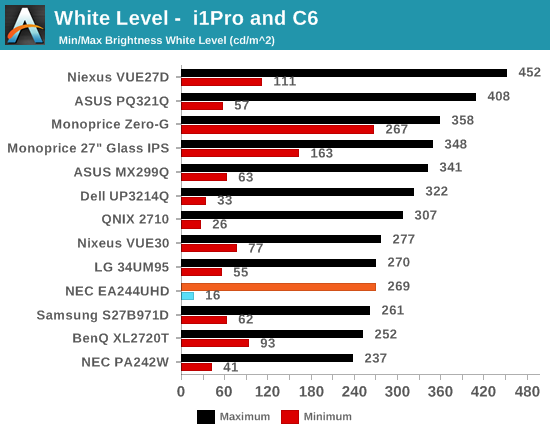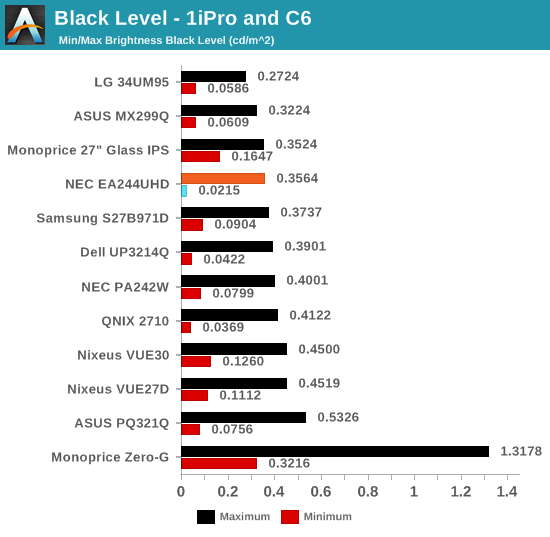NEC EA244UHD Review
by Chris Heinonen on August 7, 2014 2:30 PM ESTBrightness and Contrast
For all of the measurements I enabled the display uniformity option. This can reduce brightness and contrast ratio, but it also produces a more uniform image which I believe is worth the tradeoff. Given the target for the EA244UHD I feel most people would also leave this enabled.
The maximum light output with this enabled is only 269 cd/m2. Setting the backlight to minimum drops this all the way down to 16 cd/m2. This is a very wide range but it's not incredibly bright. Most people using the EA244UHD probably have some sort of light control but if you don’t, bright sunlight will wash it out pretty well.

With an IPS panel and uniformity compensation, black levels are what I expect to see from an NEC display. They are okay but not excellent. NEC could improve these by using a VA-panel, but that leads to sacrifices in off-angle viewing. Instead of uniformity compensation, NEC could use some sort of dimming system to improve blacks, but those almost always harm image quality.

Due to those so-so black levels we get a contrast ratio right around 750:1. IPS panels can do 1,000:1 or almost 1,200:1 now, but not with the uniformity compensation feature. When we look at display uniformity later we can see if this is worth the tradeoff that NEC has made.

This section could have been copied almost verbatim from any other NEC monitor review I have done. The EA244UHD isn’t as bright or punchy as other IPS displays, but it might offer better uniformity because of it. This is the compromise NEC has always made before, and in the past it has proven to be worthwhile.










57 Comments
View All Comments
DanNeely - Friday, August 8, 2014 - link
Win 8.1 does support different DPIs for different monitors. AIUI Metro/WPF apps have the ability to handle it built into their UI library; apps using anything else can either set a flag saying they support per monitor DPI or are locked to render in the DPI of the first monitor they open on and are scaled when moved to one with a different DPI.jay401 - Thursday, August 7, 2014 - link
That sure is an ugly stand for such an expensive monitor.Sabresiberian - Thursday, August 7, 2014 - link
The DPI isn't too high; the applications are simply behind the times. Software engineers should have had this figured out by now and acted so that UHD @ 24" wasn't a problem. And, scaling is only going of become more of an issue if they don't in the next few years.althaz - Friday, August 8, 2014 - link
Agreed. Developers (of which I am one), have the tools at their disposal to make applications scale well. For the most part however, they don't and I'm really not sure why.MikhailT - Friday, August 8, 2014 - link
From what I can see, it has to do with the custom UI frameworks. If you stick with the MS's UI widgets as much as you can, you shouldn't have a problem scaling it. However, if you're using a custom coded one, you're going to have a bad time.In Delphi for an example, some components would render just fine by setting a manifest on it but some components require you to give it custom scaling calculations to make it work. So, you can see different reactions from different components that were coded differently at different eras. For them, they just don't have the time and/or resources to figure it out as the market for folks with HiDPI screens are still a niche.
Penti - Friday, August 8, 2014 - link
Plenty of Windows components still doesn't scale at all except bitmap. If the OS it self can't do it well why should anybody follow?Pinkynator - Friday, August 8, 2014 - link
This is the first time I've ever seen calibrations to 80 and 200 cd/m2. Usually it's 120...Clorex - Friday, August 8, 2014 - link
We already have monitors that do 4k single-stream over DP 1.2; so why are there still MST monitors being released?SanX - Friday, August 8, 2014 - link
I really do not understand people who want 24" 4K monitors and not 30-40". They have different DNA. I do not understand producers either.MrSpadge - Monday, August 11, 2014 - link
That's probably why are not one of the display producers, then. Not everyone has the desk space to put 30 - 40" monitors far enough away so that the viewing experience is pleasant.